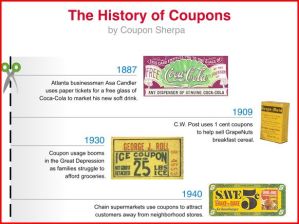Continuing on with the riveting consumer-life lecture series, which covers topics such as “Self Checkout: Burden or Blessing?” and “Customer Service Confrontations Through the Ages,” today’s discussion takes a look back at the history of a marketing ploy that seems to give customers something for nothing.
Apparently, coupons haven’t been around quite as long as the oldest profession (buy two, get one free?). Coca-Cola was the first product to get customers hooked via coupons, starting in 1887, as Coupon Sherpa tells it:
Atlanta businessman Asa Candler had a brainstorm in 1887 when he created the first coupon. At the time, brainstorm referred to a brief period of insanity, but you can’t question the Coca-Cola co-owner’s sanity when he hit upon this invaluable marketing device.
Candler’s invention transformed Coca-Cola from an insignificant tonic into a market-dominating drink. His hand-written tickets offered consumers a free glass of Coca-Cola, then priced at five cents. Between 1894 and 1913, an estimated one-in-nine Americans had received a free Coca-Cola, for a total of 8,500,000 free drinks. By 1895, Coca-Cola was being served in every state.
In the early 1900s, discounts were available on cereals thanks to coupons, and then coupon usage really took off in the Great Depression, as Coupon Sherpa’s timeline (which, unsurprisingly, is heavy on the importance of mobile coupons—Coupon Sherpa’s business model) shows:
You might have assumed that recession-dampened 2009 was a boom year for coupons. And it was, sort of: Something like 3.5 billion coupons were redeemed last year, 700,000 more than in 2008. But overall, old-fashioned physical coupons have been in decline since the early ’90s; the high point was 1992, when 7.9 billion discounts were granted via coupons.
Fascinating, I know. Up next in the lecture series: “Take a Number: Deli Meat & You.”


